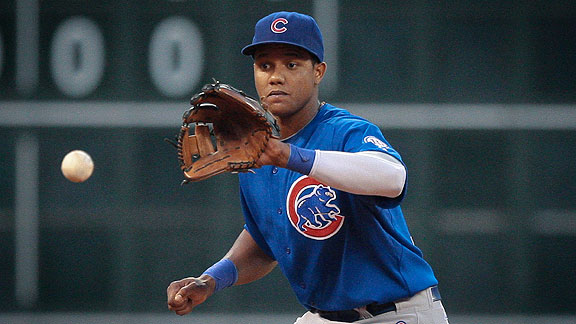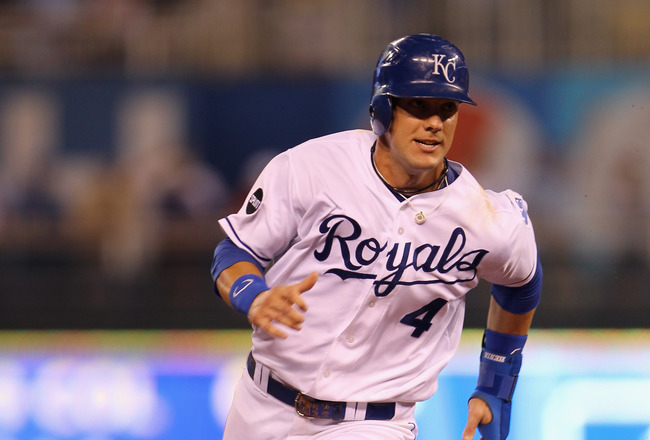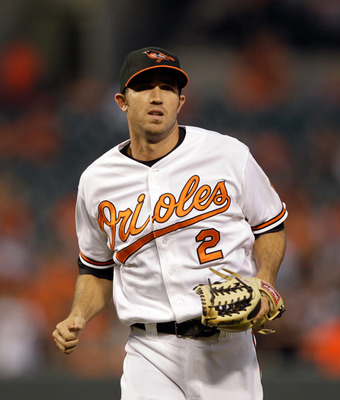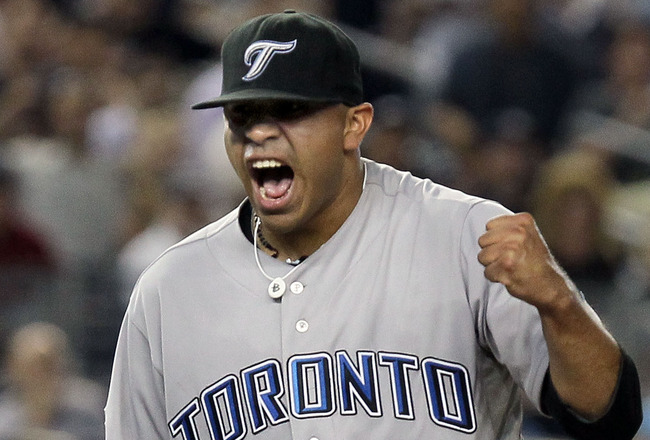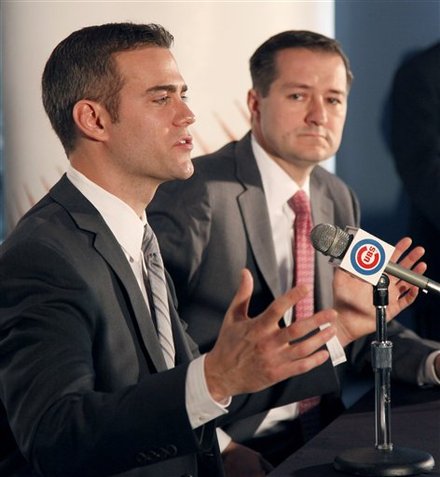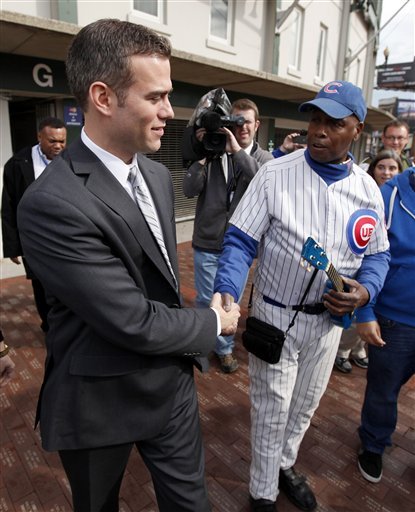 |
| AL West C: Mike Napoli |
These teams have it easy. Each NL Central winner had to be compared against each of the other five teams' player at that positon. In the AL West, however, there are only four teams, meaning the odds of winning are increased. Last season, six Rangers (Micheal Young, Elvis Andrus, Vladimir Guerrero, Josh Hamilton, Neftali Feliz, and Nelson Cruz) all took home awards. Will the Rangers sweep through the division again? Time to find out!
C Mike Napoli, TEX (2nd, first with Rangers)
The Angels are probably regretting trading Napoli away within their own division. Wait a minute...they didn't! In what has become a footnote now, Napoli was a part of the Vernon Wells trade to Toronto, but the Jays turned around and swung him to Texas for Frank Francisco just a few days later. Playing for the Texas Rangers and against his former team 18 times a year now, Napoli had one of the best offensive seasons ever for a catcher. If he had gotten a full season's worth of at-bats, it easily would have rivaled any of Mike Piazza's best campaigns. Instead, Napoli, playing in just 113 games due to injury, hit 'only' 30 homers and 75 RBIs. His .320 average and .414 OBP are unheard of for a catcher, and his .631 slugging percentage would have led MLB, however he does not have enough at-bats to qualify. No wonder the fans chant his name so much in Arlington.
Competition: Jeff Mathis (LAA), Kurt Suzuki (OAK), and Miguel Olivo (SEA).
1B Mark Trumbo, LAA
The big Trumbo came out of nowhere and took on the AL while manning first base in Anaheim, much like teammate Kendrys Morales did two years ago. The only difference is Morales can and does walk with any regularity whatsoever. Trumbo and his 25 walks? Nope. Luckily, his 29 home runs got the Angels going and kept them in the shadows of contention all season until a late surge fell short. The fan favorite got AL Rookie of the Year voting and has an impressive power swing, but will need to make adjustments if he was to continue to have success.
Competition: Mitch Moreland (TEX), Justin Smoak (SEA), and Daric Barton (OAK).
 |
| AL West 2B: Ian Kinsler Don't try this at home, kids. |
In the healthiest season of his career, Kinsler put together his best season yet. Returning to 30-30 form that eluded him in an injury-riddled 2010, he walked 27 times more than he ever had in a season. It's hard for me to quantify how great of an overall player Kinsler really is. I mean how often do second basemen hit 30 home runs? Most importantly, though, Kinsler is still one of the longest tenured on these championship contending Rangers teams and is a definite team leader, representing his entire state (the Astros don't count).
Competition: Jemile Weeks (OAK), Howie Kendrick (LAA), and Dustin Ackley (SEA).
3B Adrian Beltre, TEX (2nd, first with Rangers)
As if offense was ever a problem for the Texas Rangers, GM Jon Daniels swept in during the offseason and snatched Beltre, a big surprise to many who thought he'd go to the Angels or back to the Red Sox. The freeswinger landed in Arlington and earned every penny in his first season there, hitting 32 homers and 105 RBIs in about 4/5 of a full season. Sure the ballpark and lineup protection help, but that shouldn't take away from his .296 batting average. With an offense this great, you could almost imagine them not needing any pitching.
Competition: Chone Figgins (SEA), Alberto Callaspo (LAA), and Scott Sizemore (OAK).
SS Erick Aybar, LAA
In the past two seasons, the Angels have not been the same team they were for almost all of the 2000s. During that time the Angels were known for effectively using smallball mechanics and playing the game fundamentally well, as directed by manager Mike Scioscia. Recently, though, they haven't had the same strong fielding and baserunning skills. Aybar, though, was a holdout of the issue. Erick Aybar is fast and agile which allows him to play shortstop well. I've seen an improvement in his hitting skills for average, and he was 30-for-36 in steal attempts; clearly he's running on the right counts. Oh, and now he gets to play with Albert Pujols and C.J. Wilson.
Competition: Elvis Andrus (TEX), Cliff Pennington (OAK), and Brendan Ryan (SEA).
 |
| AL West LF: Josh Willingham |
Willingham was GM Billy Beane's biggest move last winter, and he gave the A's pretty much everything they could've asked for. Although his one season in Oakland proved a 'one-and-out' as Willingham has signed with Twins now, his run production skills were not lost on a team that seems to always be in search of such skills. His 29 home runs, including 15 at the dreaded O.co Coliseum (their new corporate naming rights deal is a website? Really? Who are these guys, the Phoenix Coyotes?), were the only major power source on the team. In fact, his 15 homers at home were more than any other teammates' total - home or road. Oh, and Willingham also had 26 RBIs more than anyone else on the team.
Competition: Vernon Wells (LAA), Trayvon Robinson (SEA), and David Murphy (TEX).
CF Josh Hamilton, TEX (2nd)
It wasn't quite MVP quality like 2010 was, but J-Ham's 2011 season was notable again for significant success but also the continued abundance of injury. This time injury struck almost right away, as Hamilton was injured in Detroit during the second week of the season. He still batted .298 and slugged .536 with 94 RBIs in only 121 games, but I still get the feeling that Hamilton has not achieved his full potential in any of his four 'full' seasons with the Rangers. Even so, he hit what should have been one of the biggest homers in World Series history with his extra-inning blast in Game 6 to take the lead. However, the Rangers - much like Hamilton - came up short again.
Competition: Peter Bourjos (LAA), Franklin Gutierrez (SEA), and Coco Crisp (OAK).
RF Nelson Cruz, TEX (2nd)
Nelly! Cruz hit 29 homers in about 4/5 of a full season, playing in 124 games (it seems like every Ranger only played 4/5). More notably, however, was that he collected 14 hits in 17 playoff games. Eight of those 14 hits were home runs. The October power came at Reggie Jackson levels this season. In the regular season, Cruz gave the Rangers an alternative, low-key power threat. He's an undoubtedly freeswinging slugger; Cruz is going to hit the ball hard somewhere.
Competition: Ichiro Suzuki (SEA), Torii Hunter (LAA), and David DeJesus (OAK).
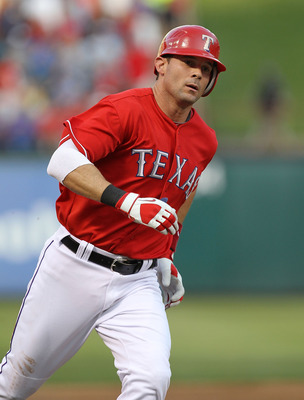 |
| AL West DH: Michael Young The best player in franchise history, Michael Young is Mr. Ranger. |
Finally, a fully healthy Ranger! If there is anyone on the Rangers invincible to injury, it has to be Young; he has missed significant time in only one year in the last decade. He also silenced critics who suggested his batting skills were declining in 2010 with another career year, collecting over 200 hits for a .338 batting average. You also know a guy is clutch and a key run producer when he gets over 100 RBIs with only 11 homers, as did Young in 2011. And instead of being traded to a mediocre Rockies team, Young got to lead his franchise to another World Series. Not too bad, I'd say.
Competition: Bobby Abreu (LAA), Casper Wells (SEA), and Hideki Matsui (OAK).
SP C.J. Wilson, TEX
Wilson must be the Angels' revenge for watching Napoli burn them in 2011. After only his second full season as a starter in the Majors, Wilson jumped ship for the Angels in a mega deal. Before you jump on the overrated bandwagon like I did at the time of the signing, consider that Wilson had an ERA on the road nearly a run better than at home. Rangers Ballpark in Arlington is one of the worst ballparks for pitchers to pitch in in the entire league, and the move to Angel Stadium should feel nice and spacious. Ignoring his awful postseason, Wilson struck out over 200 in over 200 innings and kept his overall hits allowed total low. I think these factors add up to a good, although not great, first season in Anaheim. If he can't shake off that postseason in which is WHIP was over 1.7, he's going to have some major problems.
Competition: Jered Weaver (LAA), Felix Hernandez (SEA), and Trevor Cahill (OAK).
CP Brandon League, SEA
This 28-year-old doesn't come off as your typical shutdown closer, but he gave the Mariners some real value out of the bullpen, for whatever it's worth on that team. League saved 37 of Seattle's 67 wins last season and walked only 10 in over 60 innings pitched. He struck out a decent amount and kept his WHIP low, putting together a decent season in a place where no one will appreciate it. But he's definitely the best in the division, especially when you consider that he played a full season (unlike Andrew Bailey), kept his blown saves in the single digits (unlike Jordan Walden), and didn't blow a World Series (sorry, Neftali Feliz). Nothing personal guys....
Competition: Walden (LAA), Feliz (TEX), and Bailey (OAK).
Why, yes, the Rangers get seven awards this year. Perhaps more notably, though, was that I was able to find a winner out of those 95-loss Mariners. Way to go, Brandon League!


